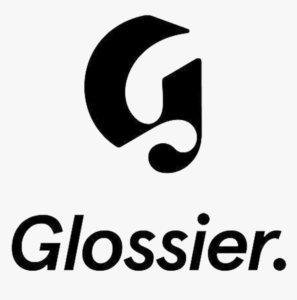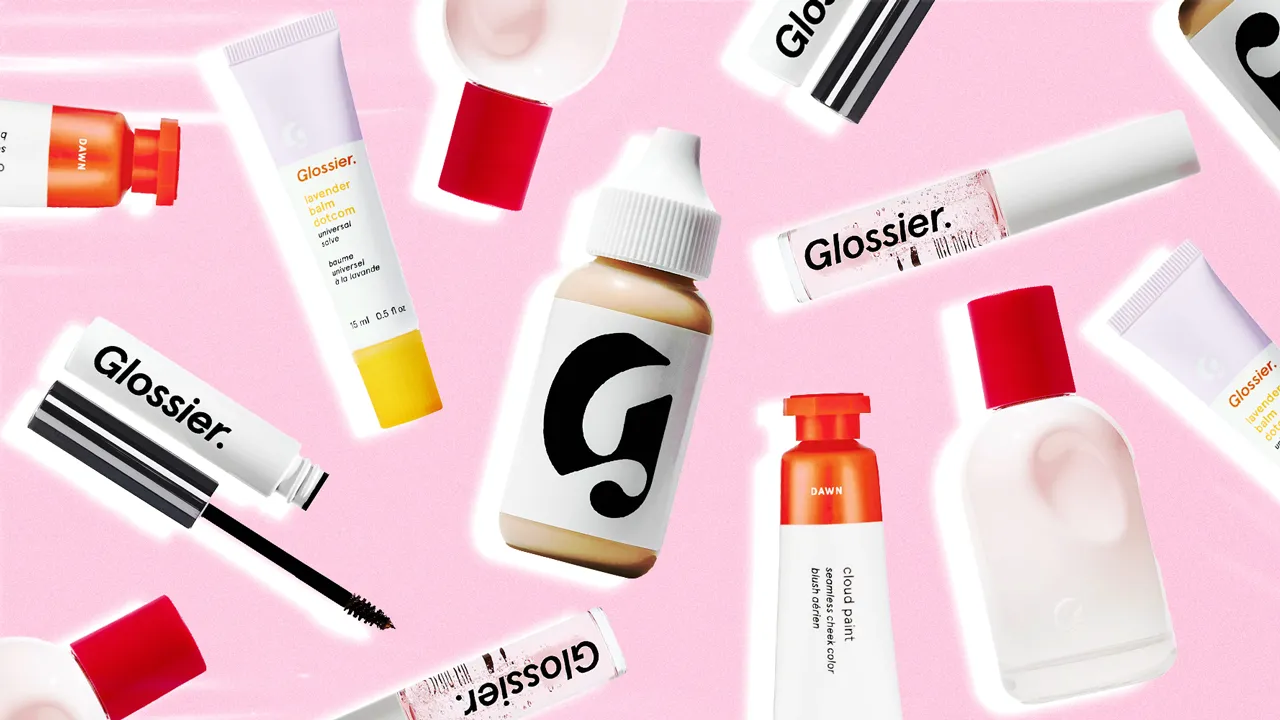Glossier is a digitally native beauty brand that was founded in 2014 by Emily Weiss. The company is known for its minimalist, millennial-friendly products and its focus on skincare and makeup that enhances natural beauty. Glossier’s products are sold exclusively through its own website and brick-and-mortar stores.
Glossier has gained immense popularity for its unique approach to beauty products and its strong presence in the beauty industry. Founded in 2014, Glossier has quickly become a favorite among consumers, especially millennials and Gen Z, due to its focus on simplicity, inclusivity, and customer engagement.
The name “Glossier” comes from the name of Weiss’ original website, “Into the Gloss.” The website was a beauty blog that focused on sharing honest reviews and recommendations from real people. Weiss launched Glossier as a way to bring the same authentic approach to beauty products.

Glossier’s products are designed to be easy to use and to give a natural, dewy finish. The company’s best-selling products include the Cloud Paint blush, the Boy Brow brow gel, and the Priming Moisturizer. Glossier also offers a variety of skincare products, including the Milky Jelly Cleanser and the Super Pure serum.
In addition to its products, Glossier is also known for its unique marketing and branding. The company’s marketing campaigns are often humorous and self-deprecating, and they often feature real people instead of models. Glossier also has a strong social media presence, and it regularly interacts with its customers on platforms like Instagram and Twitter.
Glossier has been praised for its innovative approach to beauty and its commitment to authenticity. The company has also been criticized for its high prices and its limited product range. However, Glossier remains one of the most popular beauty brands in the world, and it continues to grow in popularity.
Founding History of Glossier
Glossier has a fascinating history that begins with its visionary founder, Emily Weiss. The story of Glossier can be traced back to the year 2010 when Emily Weiss embarked on her journey in the beauty world. At that time, Weiss was working as a styling and fashion assistant for prestigious publications like Conde Nast and Vogue. During her tenure in the fashion industry, she keenly observed a significant gap between traditional beauty brands and the evolving preferences of millennial consumers.

Emily Weiss was no ordinary observer; she was a pioneer in recognizing the power of digital media and its potential to reshape the beauty industry. It was in this backdrop that she decided to create a platform that would bridge the gap between beauty brands and millennial customers. Thus, in 2010, Weiss launched her beauty blog, “Into The Gloss” (ITG). This blog became a beacon of insight into the world of beauty, offering intimate interviews with industry luminaries like model Karlie Kloss.
Through Into The Gloss, Emily Weiss collaborated with prominent beauty companies on advertising and sponsorship campaigns. In the process, she discovered a common challenge faced by these legacy brands: the inability to effectively connect with millennial consumers, who were increasingly active on platforms like Instagram. Surprisingly, some of these brands were reluctant to embrace the emerging role of social media in their marketing strategies, refusing even to hire social media editors.
Weiss had a unique vision for the future of beauty brands. She aspired to create a makeup and skincare brand that resonated with consumers on a deeply personal level. One of her iconic quotes reflects this vision: “I went through that exercise of looking across 20 or 10 beauty brands, thinking about whether or not I would buy that sweatshirt, wear that sweatshirt… I just kept coming up with the answer ‘no.'”
Emily Weiss’s determination and the growing popularity of Into The Gloss led her to make a pivotal decision. After amassing an impressive 2-3 million unique monthly site visitors, all drawn to its millennial-focused beauty content, Weiss decided it was time to transform her vision into reality. In 2014, she secured $10.4 million in funding and officially launched Glossier.
Glossier made its grand entry into the beauty world with a carefully curated selection of four products: a moisturizer, a face mist, a skin tint, and a lip balm. These initial offerings embodied the brand’s commitment to simplicity, quality, and a genuine connection with its customers.
Under Emily Weiss’s leadership as CEO, Glossier experienced a period of remarkable growth and innovation. However, her ambitious plans for Glossier to evolve into a social media platform where customers could shop and engage with one another faced challenges and controversies. In early 2022, Glossier had to make a difficult decision, leading to the layoff of over 80 employees, primarily from its tech team. This marked a significant shift away from the brand’s earlier aspirations to become a tech-focused platform.
In May 2022, Emily Weiss made another significant decision, stepping down as the CEO of Glossier. The reins of the company were passed on to Kyle Leahy, a former executive at Cole Haan and the Chief Commercial Officer of Glossier.
Today, Glossier continues to be a force in the beauty industry, celebrated for its authentic approach to beauty, product innovation, and its journey that began with Emily Weiss’s vision to bridge the gap between traditional beauty and the aspirations of millennial consumers.
Marketing Strategies of Glossier
Let’s delve into the marketing strategies of Glossier, one of the most talked-about beauty brands in recent years. Glossier’s success isn’t just about great products; it’s also about its unique and effective marketing approach. Here’s a detailed breakdown of their strategies:
1. Customer-Centric Approach
Glossier’s marketing strategy is fundamentally centered around their customers. Instead of using social media solely as a tool for broadcasting marketing messages, Glossier engages in meaningful two-way conversations with its audience on platforms like Facebook, Instagram, and Twitter.
This approach involves actively listening to customer feedback, suggestions, and concerns. Glossier takes the insights gained from these conversations and uses them as a foundation for product development. In essence, the customers’ needs and desires serve as the driving force behind Glossier’s product offerings.
What sets Glossier apart is its belief in co-creation. Customers aren’t just seen as passive consumers; they are viewed as co-creators in the product development process. To facilitate this collaboration, Glossier has even established a dedicated Slack channel for its top customers. This fosters a strong sense of community and loyalty among its customer base.
A tangible example of this customer-centric approach is the creation of the Milky Jelly Cleanser. Glossier initiated a discussion on “Into The Gloss” where over 400 customers shared their ideal face wash. Glossier then launched the Milky Jelly Cleanser, a 2-in-1 product that simplified makeup removal and face cleansing based on this customer feedback.
Moreover, when designing the product formula, Glossier’s chemist paid close attention to keywords that customers frequently used in their comments, such as “moist,” “glowy,” and “mild.” This attention to customer preferences ensured that the product resonated with their desires and needs.
As a result of this customer-centric strategy, the Milky Jelly Cleanser became one of Glossier’s best-selling products, illustrating the brand’s effectiveness in meeting and exceeding customer expectations. In summary, Glossier’s marketing strategy revolves around active customer engagement, feedback-driven product development, and a commitment to co-creating products that resonate with their audience.
2. User-Generated Content (UGC)
Glossier recognizes that its customers are its most valuable brand advocates. The brand actively encourages its customers to create and share content featuring Glossier products on social media platforms. By tapping into their customers’ creativity, Glossier not only receives a constant flow of user-generated content (UGC), but it also strengthens its bond with its community.
To motivate customers to share their positive experiences, Glossier employs several strategies. It uses hashtags like #GlosierRep and #GlosierPink to incorporate user-generated content on platforms like Instagram. This approach fosters a sense of belonging and rewards customers for their loyalty and creative contributions.
Glossier also understands the importance of curating and showcasing the best user-generated content to maintain a consistent brand image. The brand meticulously selects UGC that aligns with its aesthetic and values, featuring it on its social media platforms and website. By highlighting real customers, Glossier creates a relevant and inclusive image that resonates with its intended audience.
In addition to customer-generated content, Glossier collaborates with influencers who share its brand values. By partnering with these influencers, Glossier extends the reach of its user-generated content and reaches new audiences. These influencers serve as brand advocates, generating UGC influence and raising brand awareness.
As Glossier continues to expand and evolve, user-generated content will remain a vital component of its marketing strategy. Brands are likely to seek new ways to engage their communities and harness UGC for increased success on social media. Glossier’s commitment to authenticity and community building will remain central to its UGC efforts.
3. Minimalistic Aesthetic
Glossier’s minimalistic aesthetic is a core element of its brand identity and marketing strategy. The brand’s sleek and modern packaging, clean lines, and muted color palette reflect a sense of simplicity and sophistication that appeals to its target demographic of young, urban professionals.
Minimalism has become increasingly popular in recent years, especially among younger generations who value functionality and practicality over excessive decoration. Glossier tapped into this trend early on and used it to differentiate itself from competitors who were using flashier designs and bolder colors.
By keeping its packaging simple and understated, Glossier makes it easier for customers to recognize its products on crowded shelves and online stores. This consistency in branding also reinforces the idea that Glossier stands for quality and reliability rather than frivolousness or superficiality.
Moreover, Glossier’s minimalistic aesthetic extends beyond just its packaging. The brand’s website, social media posts, and advertising campaigns all adhere to the same visual language, further strengthening its brand image and cohesiveness.
Overall, Glossier’s minimalistic aesthetic serves as a powerful marketing tool that sets it apart from other brands while resonating deeply with its target audience.
4. Social Media Mastery
Glossier is a skincare and cosmetics brand known for its minimalist approach to beauty and its strong connection with millennial and Gen Z consumers. One key aspect of Glossier’s success is its mastery of social media marketing. Here are some details on how Glossier uses social media to promote its brand:
Authentic Content Creation: Glossier creates content that feels authentic and relatable to its target audience. This includes using real women (not professional models), natural lighting, and simple yet effective makeup looks. The brand also encourages user-generated content through campaigns like #GlossierPink and #SkincareSquad, which helps foster a sense of community among fans.
Engaging With Followers: Glossier actively engages with followers on Instagram, responding to comments and direct messages in a friendly and helpful manner. This not only improves customer satisfaction but also increases brand loyalty and word-of-mouth promotion.
Collaborating With Influencers: Glossier collaborates with micro-influencers who embody the brand’s aesthetic and values. This helps extend the brand’s reach to new audiences and adds credibility to its messaging.
Utilizing User Feedback: Glossier regularly solicits feedback from its customers via email surveys and social media polls. This input informs product development decisions and helps keep the brand relevant to changing consumer needs.
Creating Shareable Content: Glossier creates shareable content such as memes, gifs, and videos that appeal to younger generations. This type of content often goes viral, leading to increased visibility and engagement for the brand.
Driving Traffic Through Social Media: Glossier drives traffic to its website through social media posts featuring product links and promo codes. It also uses social media ads to target potential customers based on interests and behaviors.
Continuously Adapting Its Strategy: Finally, Glossier continuously adapts its social media strategy to stay ahead of evolving trends and changes in consumer behavior. For instance, the brand recently launched an IGTV series called “The Future of Skin” to provide educational content and build trust with its audience.
Glossier’s social media mastery lies in its ability to create authentic content, engage with followers, collaborate with influencers, utilize user feedback, create shareable content, drive traffic to its site, leverage user-generated content, and continuously adapt its strategy. By executing these tactics effectively, Glossier has built a passionate fan base and positioned itself as a leader in the crowded beauty industry.
5. Limited Product Releases
When it comes to rapid growth, there’s often a temptation to launch numerous product lines quickly in hopes of attracting new customers. However, Emily Weiss, the founder of Glossier, didn’t fall into this common trap. Instead, she chose to focus on what she knew best.
Even today, Glossier maintains a relatively limited product range, offering fewer than 80 beauty and skincare items. While this might appear to be a sizable collection, especially compared to their initial four-product lineup, it’s still much smaller than the extensive product catalogs of major retailers that offer numerous variations of existing products.
This deliberate choice to stick with a more concise product line aligns with Glossier’s brand identity. It reinforces the idea that beauty doesn’t have to be complicated or involve an array of products and tools. Instead, it encourages customers to discover the lipstick or mascara that suits them best and return for more when needed. This approach underscores the brand’s commitment to simplicity and effectiveness in beauty products.
6. Content-First Strategy:
Content plays a significant role in Glossier’s marketing approach, and their blog, “Into The Gloss,” continues to thrive. In addition to the blog, Glossier actively shares content on several social media platforms like Facebook, Twitter, YouTube, Pinterest, and Instagram, where they have a substantial following.
Glossier’s content stands out because it’s engaging, enjoyable, and genuinely informative. They don’t view content as merely a tool for sales; instead, it’s an opportunity to engage in authentic conversations with their beauty community. This is why they often mention products from other skincare and makeup brands, especially when discussing beauty routines tailored to various skin types and tones. By creating diverse content, including videos and articles, Glossier can reach different audiences with unique preferences and perspectives.
Glossier’s content marketing innovations are remarkable. They pioneered the “Get Ready With Me” video format, which has become a favorite among celebrities, influencers, and media publishers. They also led the way with Instagram feeds that predominantly feature content from customers, fans, influencers, and staff, rather than heavy marketing content.
Glossier’s approach to content marketing emphasizes authenticity and delivering value to their community. Their success serves as a testament to the power of building genuine connections with your audience, which in turn fosters brand loyalty and engagement.
7. Word of Mouth
A significant factor contributing to Glossier’s remarkable success lies in the steadfast loyalty of its customer base. From the very beginning, the brand has nurtured a close and personal relationship with its customers by consistently listening to their thoughts, needs, and desires.
What’s interesting is that Glossier doesn’t categorize its target customers based on typical demographics like age or location. Instead, the brand constructs consumer profiles based on psychographics. This qualitative approach revolves around understanding the psychological traits and characteristics of shoppers. In Glossier’s case, a Glossier customer is defined by their shared belief in the significance of beauty in their lives.
As a result of this approach, Glossier’s customers play a highly influential role in shaping the company’s future. This close relationship with customers has proven immensely beneficial. As Emily Weiss notes, a significant 70% of Glossier’s sales come from organic word-of-mouth connections.
8. Retail Experiences
As Glossier’s popularity continued to soar, Emily Weiss and her team made a strategic decision to expand the brand’s presence by establishing permanent physical stores as well as temporary pop-up shops. Importantly, this expansion didn’t signal a departure from their direct-to-consumer (D2C) model. Instead, the primary purpose of these brick-and-mortar locations was to serve a more significant role than just being places to shop.
These physical stores became real-world opportunities for Glossier to further nurture and strengthen its community of customers. This approach takes a page from the playbooks of other successful D2C brands like Warby Parker, Away, and Allbirds.
Glossier’s store associates, known as “offline editors,” actively promote these locations as more than just places to make purchases. They position them as brand experience centers and community hubs where consumers can explore and experiment with beauty products. These stores serve as creative spaces for beauty enthusiasts to both shop and socialize, with the added bonus of being highly photogenic and shareable on platforms like Instagram.
In summary, Glossier’s marketing strategies are built on authenticity, customer engagement, inclusivity, and a strong online presence. By fostering a sense of community and making customers feel like active participants in the brand’s story, Glossier has succeeded in creating a unique and highly effective approach to marketing in the beauty industry.
Also Read: The Quirky Marketing Strategies Of D2C Beauty Group MyGlamm
To read more content like this, subscribe to our newsletter
Go to the full page to view and submit the form.


